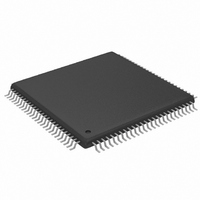MAX2038CCQ+ Maxim Integrated Products, MAX2038CCQ+ Datasheet - Page 20

MAX2038CCQ+
Manufacturer Part Number
MAX2038CCQ+
Description
IC VGA W/OCTAL MIXER 8CH 100TQFP
Manufacturer
Maxim Integrated Products
Type
Variable Gain Amplifierr
Datasheet
1.MAX2038CCQT.pdf
(24 pages)
Specifications of MAX2038CCQ+
Applications
Medical Ultrasound Imaging, Sonar
Mounting Type
Surface Mount
Package / Case
100-TQFP Exposed Pad, 100-eTQFP, 100-HTQFP, 100-VQFP
Lead Free Status / RoHS Status
Lead free / RoHS Compliant
Ultrasound VGA Integrated
with CW Octal Mixer
The serial interface of the MAX2038 programs the LO for
16, 8, or 4 quadrature phases using a serial shift register
implementation. Data is shifted into the device on DIN.
The serial shift register clock is applied to the CLK input.
The serial shift register has 5 bits per channel. The first 4
bits are for phase programming, and the fifth bit enables
or disables each channel of the mixer array.
Each mixer can be programmed to 1 of 16 phases;
therefore, 4 bits are required for each channel for pro-
gramming. The master high-frequency mixer clock is
applied to differential inputs LO_LVDS+ and LO_LVDS-
(for modes 1 and 2) and LO_ (for modes 3 and 4). The
LOAD input is provided to allow the user to load the
phase counters with the programming values to gener-
ate the correct LO phases. The input signals for mixing
are applied to the eight differential inputs, CWIN_+ and
CWIN_-. The summed I/Q baseband differential outputs
are provided on CW_IOUT+/- and CW_QOUT+/-.
CW_M1 and CW_M2 are used to select one of the four
possible modes of operation. See Table 1.
Figure 5. Shift Register Timing Diagram
20
______________________________________________________________________________________
CLOCK ON
LOAD
CLK
DIN
MIXER
CLOCK ON
MIXER
t
DCLKPWH
t
DSU
t
CLOCK OFF
HLD
MIXER
t
DCLK
Serial Interface
t
DCLKPWL
CLOCK OFF
MIXER
The serial interface is designed to allow multiple
devices to be easily daisy chained in order to minimize
program interface wiring. DOUT is available for this
daisy-chain function.
During normal CWD operation, the mixer clock at LO_ or
LO_LVDS+/- is on and the programming signals on DIN,
CLK, and LOAD are off. (LOAD = high, CLK = low, and
DIN = don’t care, but fixed to a high or low). To start the
programming sequence, turn off the mixer clock. Data is
shifted into the shift register at a recommended 10MHz
programming rate or 100ns minimum data clock
period/time. See Figure 5 for timing details.
After the shift registers are programmed, pull the LOAD
bus to logic-low and then back to logic-high to load the
internal counters into I/Q phase divider/selectors with
the proper values. LOAD must remain low for a mini-
mum time of t
start beamforming. The clock must turn on such that it
starts at the beginning of a mixer clock cycle.
CLH
CLOCK OFF
Programming the Beamformer
MIXER
. The user turns on the mixer clock to
t
CLH
t
CLOCK ON
LD
MIXER
t
LDMIXCLK
CLOCK ON
MIXER












